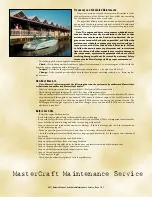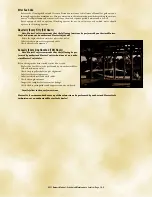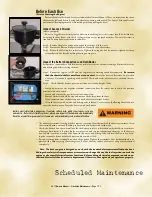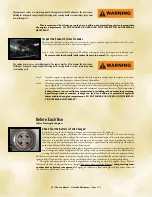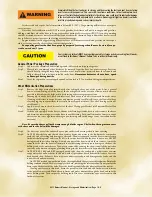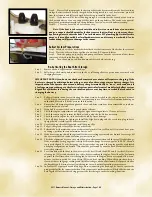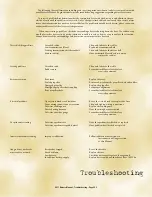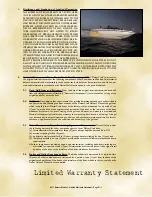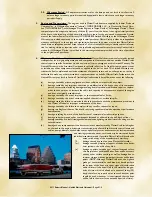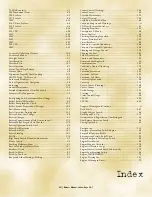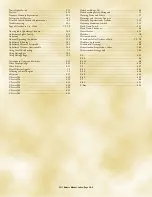
2011 Owners Manual...Storage and Winterization...Page 18-2
Completely filling the fuel tank prior to storage and then sealing the fuel tank vent does not allow
room for necessary expansion. This can result, in extreme conditions, in fuel tank rupture. Such
release of fuel into the boat and potentially into the storage area could result in substantial damage
to the boat and contact with any spark (such as a flame-producing pilot light in a heater) could also
result in property damage and serious injury or death.
It is desirable to keep the fuel’s temperature below 80 F. (26 C.) The gumming will increase as tempera-
tures increase.
Note that fuel stabilizers work ONLY in fresh gasoline. Stabilizers will not cure oxygenated gasoline.
Adding a stabilizer when the boat is being prepared for outings after storage will NOT clean the gumming
that has occurred or remove water from the fuel tank or otherwise eliminate any problems that have occurred
due to failure to properly prepare the fueling system for storage.
Engine manufacturers suggest using Federal or State of California reformulated gasoline whenever pos-
sible as it stores as well or better than conventional gasoline.
Even quality gasoline that has been properly prepared for storage should never be stored for a pe-
riod to exceed one (1) year.
Fuel systems on all boats MUST be properly prepared for storage periods exceeding two (2) weeks,
as outlined in this Owner’s Manual. Failure to do so will void the warranty.
General Power Package Preparation
Step 1:
Lubricate the throttle and shift linkages and cables with multi-purpose grease.
Step 2:
MasterCraft recommends that batteries be removed from the boat for winter storage. Batteries
should be fully charged before being stored in a cool, dry location, protected from the elements and
fully re-charged before being re-installed in the boat.
Never store batteries close to heat, spark
or flame-producing devices.
Step 3:
Leave the engine box cover propped open about two inches (2”) to ventilate the engine compartment.
Other Winterization Preparations
Step 1:
Remove the bilge drain plug immediately after taking the boat out of the water. After a general
bow-to-stern washing, raise the bow of the boat higher than the stern to allow as much water as
possible to drain from the bilge, while performing other storage preparations.
Step 2:
Thoroughly clean the hull, deck and interior of the boat as soon as it is removed from the water.
Cleaning at this time is easier because any marine growth is still wet. Be sure to allow a few days
of air drying to prevent mildew that results from trapped moisture. (See the Cleaning section of
this Manual.)
Step 3:
Apply a coat of wax to the entire surface of the boat. We suggest MasterCraft Premium Marine Wax
for excellent coverage.
Step 4:
If the boat is equipped with a heater, shower or ballast bags/tanks, be sure to disconnect the hoses
and drain any remaining water in the lines to avoid freezing. Even small amounts of water in any of
these areas can cause significant damage upon freezing and such damage is not covered under the
warranty!
Note: Be sure that hoses will not become entangled in the engine V-belt when the engine turns over
or the hose and/or the belt will be damaged.
Step 5:
Use duct tape to seal the exhaust flaps to prevent dirt and nesting rodents from entering.
Step 6:
On CSX 265 models equipped with the hot water heater, any water in the tank must be removed to
avoid the risk of freezing and damage to the tank. The water pumped into the heater comes from a
freshwater holding tank, and it can be left in the water heater when the boat is not in use, EXCEPT
during extended periods of storage. As with any part of the boat in which there is water, it must be
removed at the time the boat is winterized to avoid freezing that may cause damage to the boat, the
holding tank or the water heater. The water is removed by running the shower until all the water has
come out or by disconnecting the plumbing fittings in the forward service bay under the helm seats.
Step 7:
On 255V, X-55, 280V and X-80 equipped with heads, clean the tanks with a mild cleaner or warm
soapy water that will not harm the finish. Avoid all petroleum-based household cleaners. Store the
head dry and clean. Failure to do so may cause unnecessary odors and damage to the tanks, and this
is not covered under warranty.
On CSX 265 models equipped with heads, thoroughly flush the system with fresh water. Empty the
holding tank and shut off the water supply to the head, removing the inlet waterline. Do not remove the
brass cap on the bottom of the valve. Press the flush lever until all water is drained from the system.
If using anti-freeze in this head, drain the potable water tank and add freshwater anti-freeze
to the potable water tank. Flush the anti-freeze and water mixture through the head and into the
waste holding tank. Then empty the holding tank. Never use automotive-type anti-freeze in this
freshwater system.
Содержание prostar 190 2011
Страница 26: ...Guide to Individual Models 2011 Owners Manual Guide to Individual Models Page 4 1...
Страница 81: ......
Страница 93: ......
Страница 105: ......




